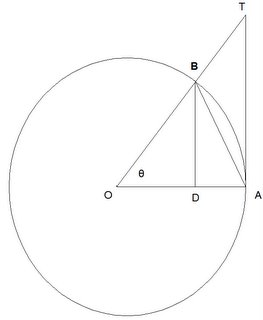Lemma 1: If two triangles have one angle equal to one angle and the sides around the equal angle proportional, then the two triangles are equiangular.
Proof:
(1) Assume that ∠ BAC ≅ ∠ EDF and BA/AC = ED/DF
(2) There exists a point G such that ∠ FDG ≅ ∠ BAC and ∠ DFG ≅ ∠ ACB [See here for details on the construction.]
(3) ∠ B ≅ ∠ G [since the angles of a triangle add up to 180 degrees, see Lemma 4 here for details]
(4) triangle ABC is equiangular with triangle DGF [from step #2 and step #3]
(5) From the properties of equiangular triangles (see here), we know that:
BA/AC = GD/DF
(6) From our assumption in Step #1, we can conclude that:
GD/DF = ED/DF
(7) And from step #6, we can conclude that:
ED ≅ GD
(8) From Step #1 and Step #2, we can conclude that:
∠ EDF ≅ FDG
(9) We can now conclude that triangle DEF ≅ triangle DGF from Side-Angle-Side (see Postulate 1 here) since:
(a) DF ≅ DF
(b) ∠ EDF ≅ ∠ FDG [Step #8]
(c) ED ≅ GD [Step #7]
(10) ∠ ACB ≅ ∠ DFE since:
(a) ∠ ACB ≅ ∠ DFG [Step #2]
(b) ∠ DFG ≅ ∠ DFE [From Step #9, see here for properties of congruent triangles if needed]
(11) Finally, we can conclude that triangle ABC is equiangular with triangle DEF since:
(a) ∠ BAC ≅ ∠ EDF [By assumption in Step #1]
(b) ∠ ACB ≅ ∠ DFE [By Step #10]
(c) ∠ B ≅ ∠ E [Since angles of triangles add up to 180 degrees]
QED
Lemma 2: Those triangles which have one angle equal to one angle and which the sides about the equal angles are reciprocally proportional, are equal.
Proof:
(1) Let the sides of triangle ABC and triangle ADE be reciprocally proportional so that:
AE/AB = CA/AD
(2) Since triangle ABC and triangle ABD share the same height, we can conclude that (see here):
AC/AD = area triangle ABC/area triangle ABD
(3) Likewise, since triangle ADE and triangle ABD share the same height, we can conclude that:
AE/AB = area triangle ADE/triangle ABD
(4) Therefore, triangle ABC/triangle ABD = triangle ADE/triangle ABD.
(5) But then we have:
area triangle ABC * area triangle ABD = area triangle ADE * area triangle ABD
(6) And if we divide both sides by the area of triangle ABD, we get:
area triangle ABC = area triangle ADE.
QED
Lemma 3: Similar triangles are one to another in the square ratio of corresponding sides.
Proof:
(1) Let triangle ABC and triangle DEF be equiangular triangles such that:
∠ A ≅ ∠ D
∠ B ≅ ∠ E
∠ C ≅ ∠ F
(2) There exists a point G such that BG = [(EF)*(EF)]/BC
(3) From (#2) we have:
1/BG = BC/[(EF)*(EF)]
which implies that:
EF/BG = BC/EF
(4) From a Property of Equiangular Triangles (see here if needed), we know that:
AB/BC = DE/EF
so that:
AB/DE = BC/EF
(5) We can also conclude that triangle ABG has equal area to triangle DEF since:
(a) ∠ B ≅ ∠ E (step #1)
(b) AB/DE = EF/BG (from combining step #3 with step #4)
(c) Lemma 2 above
(6) We can also conclude that BC/BG = (CB)2/(EF)2 since:
BC*BG = EF*EF (step #2)
And if we multiply BC to both sides, we get:
(BC)2*BG = (EF)2*BC
If we divide BG from both sides and (EF)2 from both sides, we get:
(BC)2/(EF)2 = BC/BG
(7) Since triangle ABC and triangle ABG have the same height, we can conclude (see here):
CB/BG = area triangle ABC/area triangle ABG
(8) Applying setp #6, gives us:
area triangle ABC/area triangle ABG = (BC)2/(EF)2
(9) Finally, from step #5, we have:
area triangle ABC/area triangle DEF = (CB)2/(EF)2
QED
References
- David Joyce, Euclid's Elements
